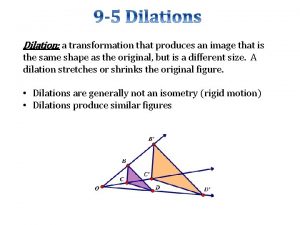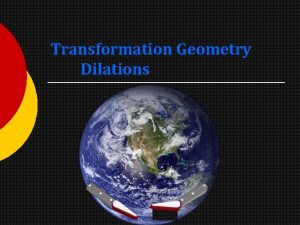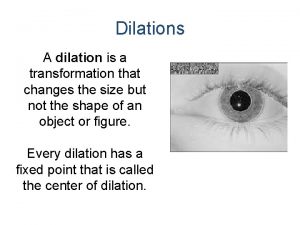Dilations A dilation is a transformation that produces











- Slides: 11

Dilations • • • A dilation is a transformation that produces an image that is the same shape as the original, but is a different size. A dilation stretches or shrinks the original figure. The description of a dilation includes the scale factor (or ratio) and the center of the dilation.

Dilation can mean tripling the size of this triangle

…or doubling the dimensions of this rectangle

…or reducing this trapezoid to 2/3 of its original size

Let’s dilate this rectangle (1, 3) (1, 1) (4, 3) (4, 1)

Let’s dilate this rectangle (2, 6) (8, 6) The side lengths have increased by a factor of 2 (1, 3) The area has increased by a factor of (4, 3) (2, 2) 4 (8, 2) (1, 1) (4, 1) What is the pattern to how the coordinate values change from the smaller to the larger rectangle?

Let’s dilate this rectangle (2, 6) (8, 6) (1, 3) (1, 1) (2, 2) (1, 3) (2, 6) (4, 1) (8, 2) (4, 3) (8, 6) (4, 3) (2, 2) (8, 2) (1, 1) (4, 1) Each coordinate is just doubled in value

Other ways of transforming polygons on the coordinate plane include…

Here the coordinates ( – 3, 1), (– 3, 4), (– 1, 4), and (– 1, 1) are reflected across the x-axis to give us (– 3, – 1), (– 3, – 4), ( – 1, – 4), and (– 1, – 1) A reflection (or flip) is a transformation across a line, called the line of reflection. Each point and its image are the same distance from the line of reflection. Let’s reflect this rectangle across the x-axis

A translation (or slide) is a transformation in which all the points of a figure move the same distance in the same direction. Let’s move this rectangle from here… Here the coordinates (– 3, 1), (– 3, 4), (– 1, 4), and (– 1, 1) are changed in this way: (x + 5, y – 2) right 5, down 2 …to here So now we have (2, – 1), (2, 2), (4, 2), and (4, – 1)

A rotation (or turn) is a transformation about a point P, called the center of rotation. Each point and its image are the same distance from P. This is an example of a rotation around the central point (– 2, – 1) The only examples of this that you will need to know for now is how to recognize them graphically. Calculating rotations will come later
 Dilation transformation
Dilation transformation Tìm vết của đường thẳng
Tìm vết của đường thẳng Sau thất bại ở hồ điển triệt
Sau thất bại ở hồ điển triệt Thơ thất ngôn tứ tuyệt đường luật
Thơ thất ngôn tứ tuyệt đường luật Hãy nói thật ít để làm được nhiều
Hãy nói thật ít để làm được nhiều Thơ thất ngôn tứ tuyệt đường luật
Thơ thất ngôn tứ tuyệt đường luật Tôn thất thuyết là ai
Tôn thất thuyết là ai Phân độ lown ngoại tâm thu
Phân độ lown ngoại tâm thu Walmart thất bại ở nhật
Walmart thất bại ở nhật Gây tê cơ vuông thắt lưng
Gây tê cơ vuông thắt lưng Block nhĩ thất độ 2 mobitz 1
Block nhĩ thất độ 2 mobitz 1 Dilations
Dilations




















